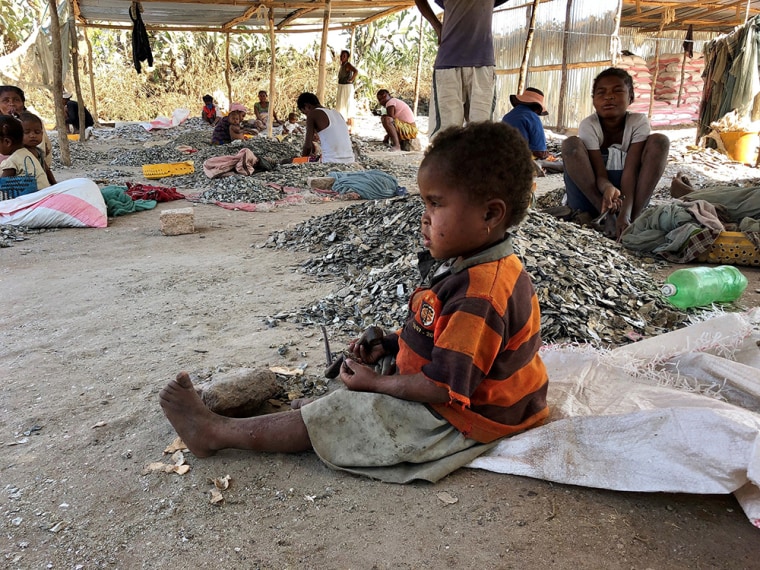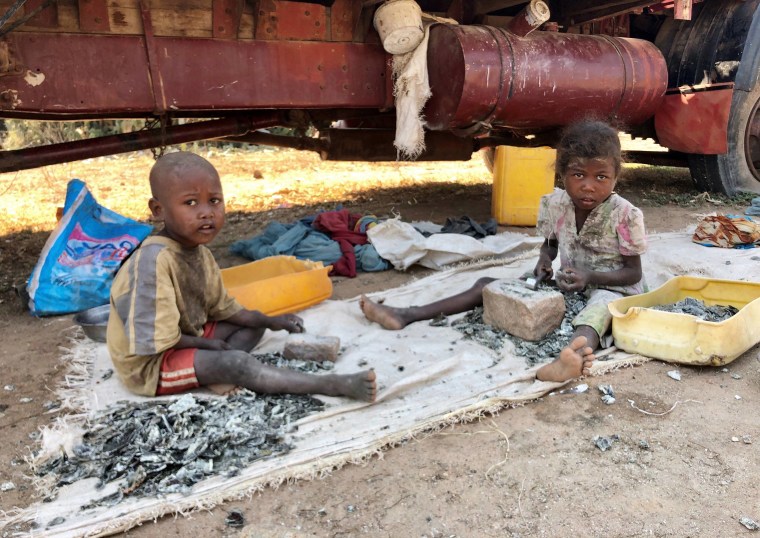The Department of Labor has identified mica mined in Madagascar as a good produced by child labor, a distinction that advocates say will put pressure on companies to modify their supply chains.
The move follows a 2019 NBC News investigation that revealed children as young as 4 were working in underground pits to mine mica in Madagascar. A majority of the minerals flow to China where they are processed into products shipped to the U.S., including hair dryers, batteries, even train parts.
Children working in mica mines have developed back and breathing problems from descending into darkened pits without safety gear to collect mineral shards for pennies an hour. Others work at mica processing centers where they spend hours a day banging on mica sheets with socket wrench-like tools.
In its report, “2020 List of Goods Produced by Child or Forced Labor,” the Labor Department’s Bureau of International Affairs referred to reports, including the NBC News story, that young children were working in dangerous conditions to produce mica in southern Madagascar.
“Adolescent boys dig mines and risk injury from falling rocks as they use sharp tools to extract mica from underground with no protective gear,” reads the report, published in September.
“Both boys and girls work long hours in the hot sun carrying heavy loads and are exposed to mica and sand dust throughout the production process. Child laborers usually do not attend school, and girls working at the mines are particularly vulnerable to commercial sexual exploitation.”
Mica is particularly prized in the electronics and automotive worlds because it acts as a natural insulator that doesn't overheat even in extreme temperatures.
NBC News reviewed hundreds of shipping records and traveled more than 400 miles with the Dutch child protection group, Terre des Hommes through Madagascar’s remote southern region to document the flow of mica mined by children.
Terre des Hommes estimates at least 10,000 children are involved in Madagascar’s mica sector.

The organization’s CEO, Carel Kok, said the Bureau of International Affairs’ “consequential actions are applauded.” Terre des Homes has been dedicated to raising awareness about child labor in the mica sector since 2016 and is currently expanding its mica program in Madagascar to “help permenently eliminate child labor from the global mica supply chain.”
Additionally, the Bureau’s report reveals it intends to fund a $4.5 million project to “address child labor in the mica-producing communities of Madagascar” and is working to select “an implementing partner soon.”
“It’s just amazing,” said Fanny Freemont, executive director of the Responsible Mica Initiative. “USDOL is both sending a strong signal for the need [for] behavioral change in terms of international sourcing, and at the same time some resources to do so. If it does not relieve mica-using companies from their individual responsibilities, this is a strong enabling tool for them to collectively kick-start remediation activities.”
Cornelius Williams, UNICEF’s associate director of child protection, said the use of children in mines is “one of the worst forms of child labor and one of the worst violations of children’s rights.”
The industry was first flagged in the bureau’s 2018 list for the involvement of child labor in India. The inclusion of Madagascar’s mica marks one of 25 additions to the bureau’s 2020 list.
According to the report, “the addition of goods and products to ILAB’s List is a sign of hope. These additions help shed light on problems shrouded in misinformation and hearsay, hidden away from the demanding gaze of society – a society that asks for human rights and respect for the dignity of every person, yet may not know the grim realities.”
